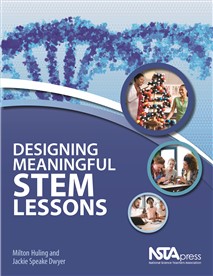StEMT: A New Process for Designing Meaningful STEM Lessons
By Carole Hayward
Posted on 2018-08-24
 A simple, practical, and methodological process for elementary and middle school teachers to implement meaningful STEM activities in the classroom that are not labor intensive, can be used with existing lessons, correlate with “A Framework for K-12 Science Education,” and are much more than just a “cool” project.
A simple, practical, and methodological process for elementary and middle school teachers to implement meaningful STEM activities in the classroom that are not labor intensive, can be used with existing lessons, correlate with “A Framework for K-12 Science Education,” and are much more than just a “cool” project.
This is what veteran science educators Drs. Milton Huling and Jackie Speake Dwyer set out to accomplish when they coauthored their book, Designing Meaningful STEM Lessons.
The book is based on a conceptual framework called StEMT, which was created by Huling. Dwyer was first introduced to it when attending a professional training being facilitated by Huling. When she saw the term being projected onto the screen in front of her, she assumed, rightfully so, that the word STEM had been misspelled.
If technology is the solution to a human problem, Huling posited, and most papers about STEM mention problem solving as a component, it only “made sense” that the solution to the problem must be the technology that is produced. (This conflicts with the view that the “T” in STEM is all about integration of technology and not a solution to a problem.) Once teachers can conceptualize the difference between science and technology, it’s much easier to understand how much and engineering are used to bridge the divide, Huling added.
StEMT is …
St Science infusing (raised through the power of: Technology (a.k.a. Good Science)
E Engineering design process
M Mathematical practices and habits of mind
T Technology as a product or solution to a problem
Huling and Dwyer used the StEMT framework to create “effective, relevant science instruction that provides real-world experiences for every child … by providing a mechanism to link science and mathematics to activities that promote constructionist learning to allow students to be cognitively challenged through questioning and problem-solving opportunities.”
The authors shared their StEMT vision at many district trainings as well with the Florida Association of Science Supervisors, and it’s clear that they put feedback they received to good use in designing the nine chapters of this book. Huling and Dwyer start out by providing an overview of the full STEM landscape as well as a rationale for their StEMT conceptual framework; they then provide step-by-step instructions on how a typical science lesson can be “StEMTified.”
The 14 lessons that are included are divided into Earth and Space Sciences; Life Sciences; and Physical Sciences, and each is quite intensive in its level of well-thought out detail. Each begins with a Teacher Brief and the prior knowledge students should have, by end of grade 5 as well as grade 8, then transitions into what students should be doing, the crosscutting concepts at work and the disciplinary core idea. Teachers know the instructional duration required for each lesson as well as the materials, safety notes, and guiding questions to ask. Information on how to formatively assess the lesson’s effectiveness is also included.
Designing Meaningful STEM Lessons “bring clarity to the sometimes murky STEM conversations in the ways that will be helpful to teachers and administrators alike,” says Sherry Sutherland, editor of Science Education, and director of the School of Teacher Education and FSU-Teach at Florida State University, who wrote the book’s foreword. “Informed by research findings and the practicalities of the work in schools and situated in national conversations around the Next Generation Science Standards, the StEMT instructional model and the activities Huling and Dwyer offer will be useful to a wide swarth of K-12 science teachers.”
More information on this book, including a free sample chapter, can be found here. This book is also available as an e-book.
Follow NSTA
Disclaimer: The views expressed in this blog post are those of the author(s) and do not necessarily reflect the official position of the National Science Teaching Association (NSTA).


